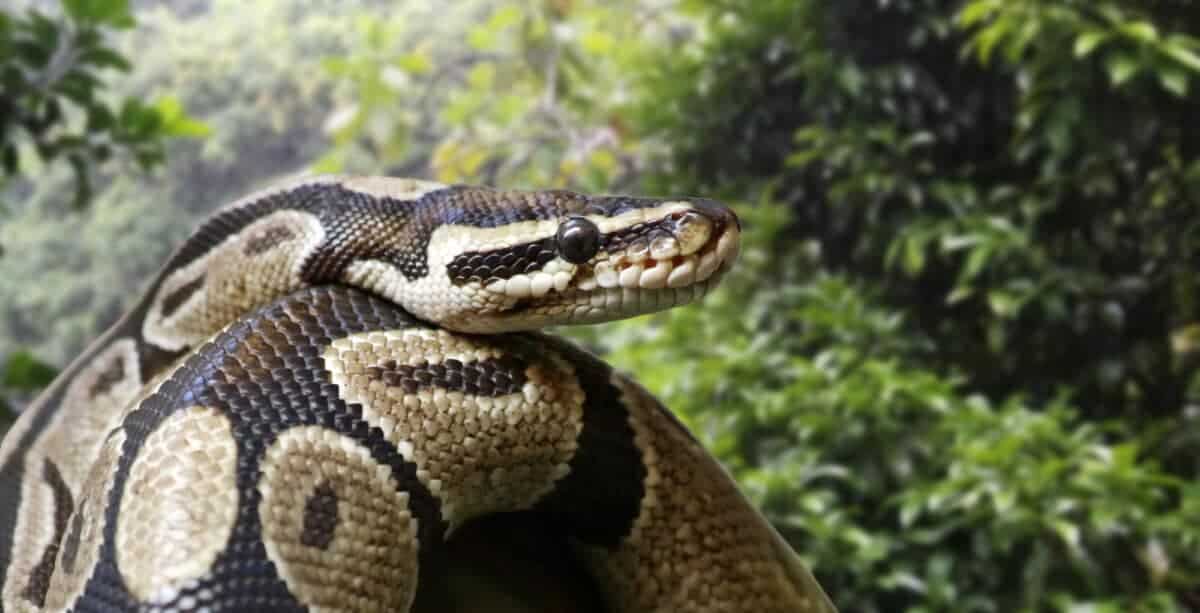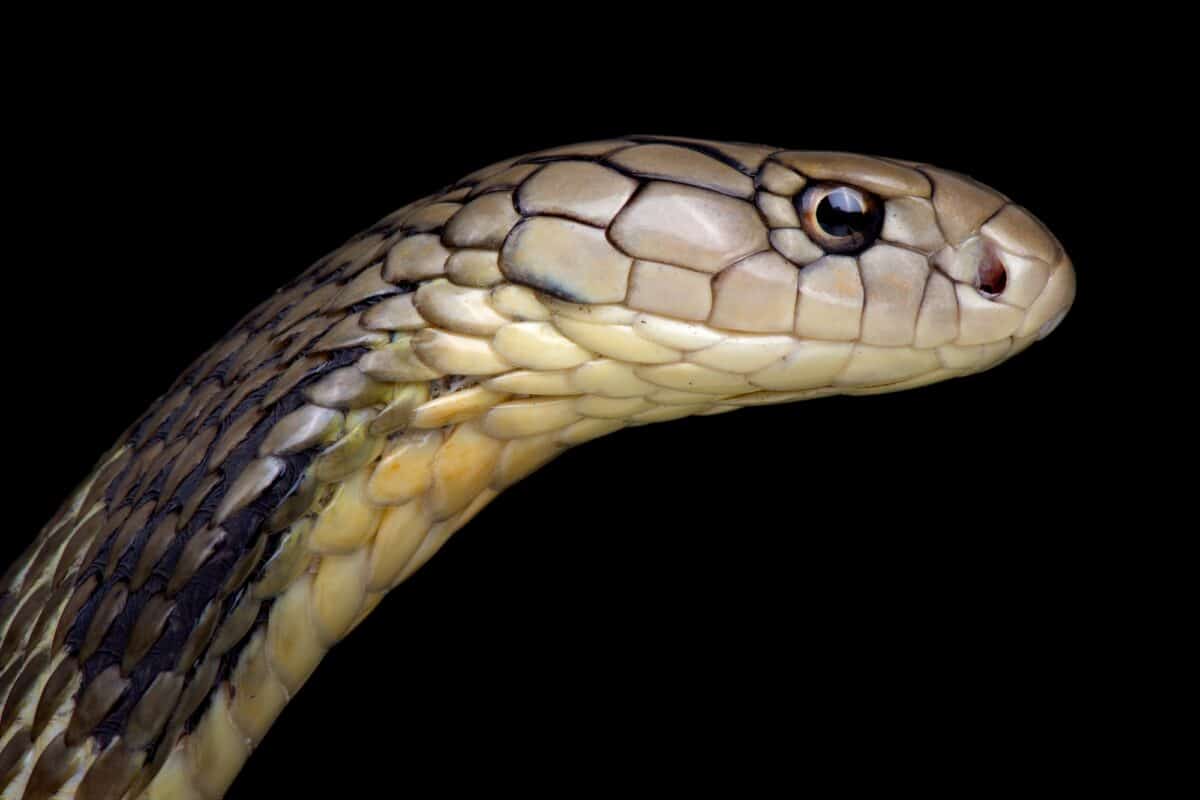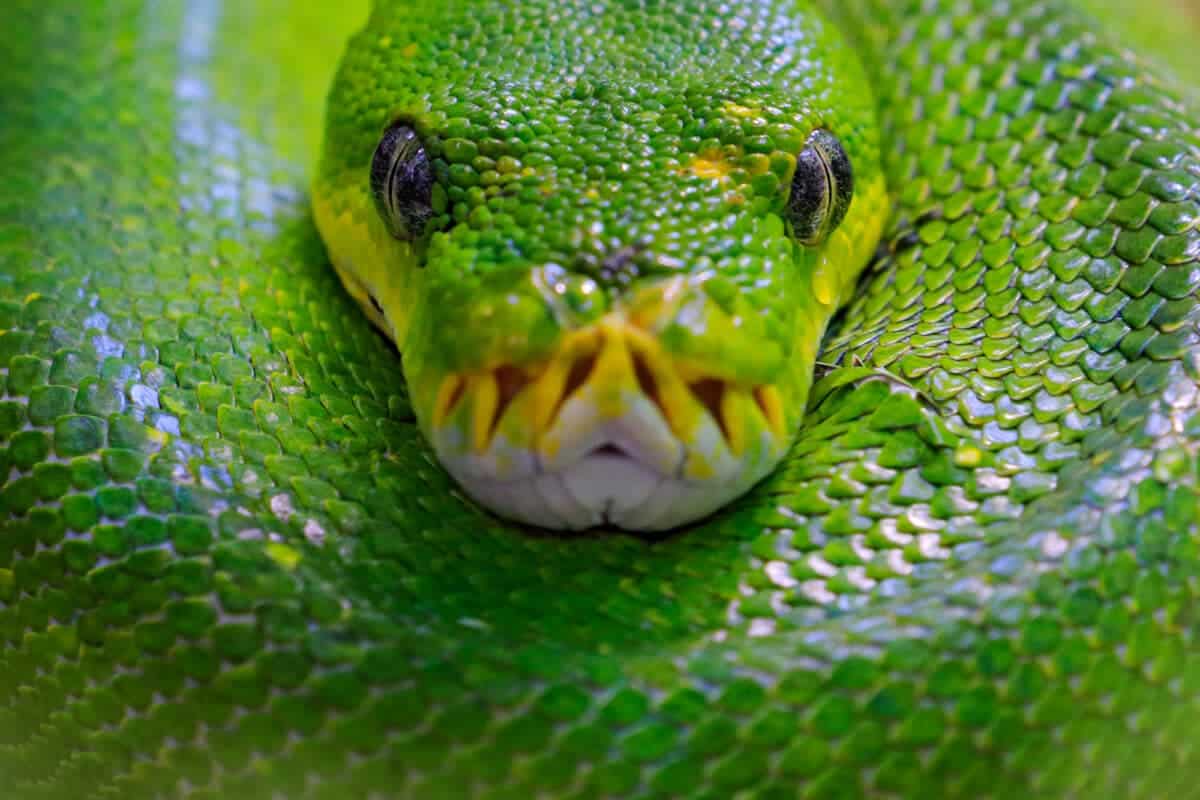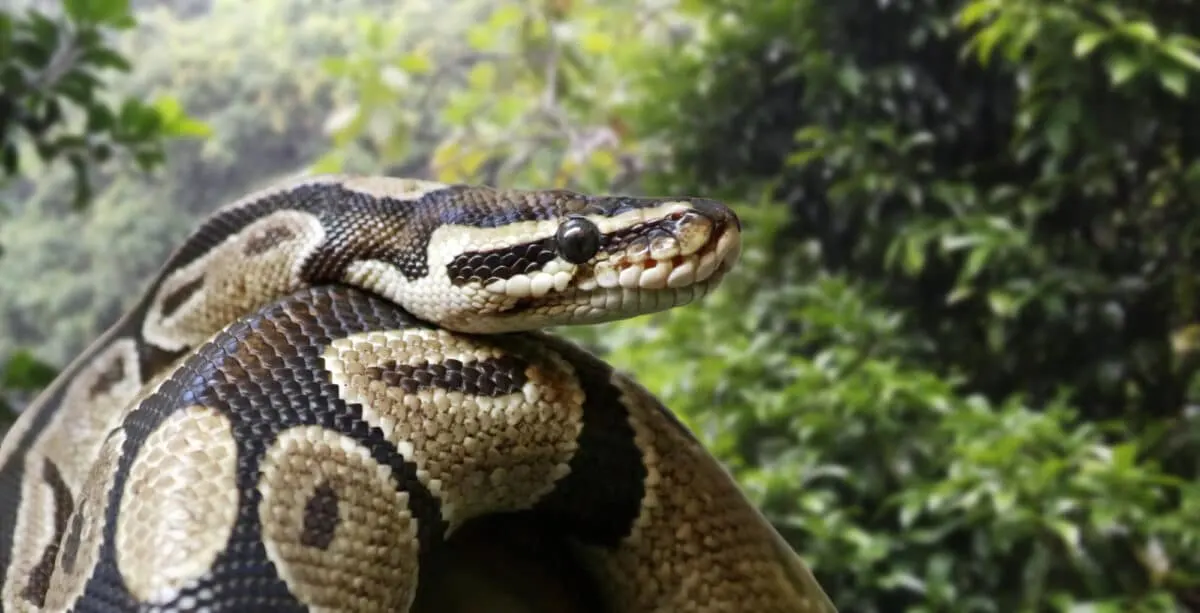This article dives into these awe-inspiring reptiles’ distinct characteristics, behavior, and unique attributes. As experts in animals and healthcare, we understand the importance of comprehending the traits of various species to appreciate their diversity, promote coexistence, and safeguard our ecosystems.
A Detailed Comparison of Pythons & Chinese Cobras
| Pythons | Chinese Cobras | |
| Family | Pythonidae | Elapidae |
| Size | Large to Giant, ranging from 3 to over 20 feet | Medium-sized, typically between 4 to 6 feet |
| Physical Characteristics | – Muscular bodies with no venomous fangs | – Distinctive hood and potent venomous fangs |
| Hunting Method | Constriction, squeezing and suffocating prey | Venomous bite, injecting potent neurotoxic venom |
| Venomous | Non-venomous | Highly venomous, capable of inflicting lethal bites |
| Geographic Range | Found in Africa, Asia, and Australia | Found primarily in Southeast Asia |
| Habitat and Adaptations | – Adapted to diverse habitats such as grasslands, forests, and swamps | – Thrive in various environments, including forests and grasslands |
| Reproductive Behavior | – Oviparous, laying eggs | – Ovoviviparous, giving birth to live young |
| Prey Preferences | – Feed on small mammals, birds, and occasionally reptiles | – Diet includes rodents, small birds, and other snakes |
| Conservation Status | Some species face threats and are listed as vulnerable or endangered | Vulnerable to habitat loss and human persecution |
| Human Interaction | Rarely pose a threat to humans | Potentially dangerous due to venomous nature |
Python – The Constrictor

Description and Characteristics of Pythons
Pythons are a group of non-venomous snakes belonging to the family Pythonidae. These serpents are known for their powerful constriction method of subduing their prey.
While several species of pythons exist, the larger ones, such as the Burmese and the African Rock Python, can reach impressive sizes, often exceeding 20 feet. These giant snakes are among the largest reptiles in the world, showcasing the diversity and adaptability of the Pythonidae family.
Python’s Habitat and Geographical Distribution
Pythons have a wide geographical distribution in various regions across Africa, Asia, and Australia. They exhibit remarkable adaptability to habitats, including grasslands, forests, swamps, and urban environments. Their preferred habitats are usually warm and humid, allowing them to thrive and maintain their cold-blooded metabolism. The ability of pythons to live in such diverse environments highlights their versatility as successful predators.
These magnificent snakes possess unique hunting techniques and a role to play in their ecosystems. Let us now venture into the world of the Chinese Cobra and discover how it contrasts with Python in its fascinating characteristics.
Chinese Cobra – The Venomous Predator

Description and Traits of Chinese Cobra
The Chinese Cobra, a member of the Elapidae family, is a venomous snake that commands respect and caution. Known for its distinctive hood, the Chinese Cobra uses its venom to immobilize its prey and protect itself from potential threats. While not as large as pythons, Chinese Cobras can grow to a formidable length of around 4 to 6 feet. Their venomous fangs and potent neurotoxin make them a force to be reckoned with in the animal kingdom.
Venom and Its Effects on Humans and Other Animals
The venom of the Chinese Cobra is a complex mixture of proteins and enzymes that targets the nervous system of its prey. When injected into a victim, it can lead to paralysis and, in severe cases, respiratory failure. The potency of its venom poses a significant threat to its prey and potential predators, including humans. Due to this, any encounter with a Chinese Cobra should be approached with extreme caution and respect for their natural habitat.
A Clash of Titans – King Cobra vs. Python
As we delve into the intriguing world of snakes, one matchup that often captures the imagination is the confrontation between King Cobra and the Python. Both species are formidable predators, and their potential encounters showcase the fascinating dynamics of the animal kingdom.
A Comparison Between the King Cobra and Python
The King Cobra (Ophiophagus hannah) is a highly venomous snake renowned for its size and deadly nature. It is the longest venomous snake in the world, capable of reaching lengths of up to 18 feet.
On the other hand, the Python, especially the giant species like the Burmese Python (Python bivittatus), can exceed even the King Cobra’s length and rival it in sheer power.
Habitat Overlap and Potential Conflicts
The King Cobra and Python habitats can sometimes overlap, especially in certain regions of Southeast Asia. These areas include dense forests, grasslands, and swamps, providing ample opportunities for encounters between these two apex predators.
When their paths cross, a battle for dominance might ensue.
Despite their impressive size, both animals are known to avoid confrontations whenever possible, as injuries could hinder their ability to hunt and survive. It is essential to recognize that such interactions are relatively rare, and most snakes, including these giants, prefer to avoid conflict and save their energy for hunting and reproduction.
The Outcome Of Confrontations Between These Species
The outcome of a confrontation between a King Cobra and a Python is hard to predict definitively. It largely depends on various factors, such as the size and health of each snake, the element of surprise, and the nature of the encounter.
While King Cobras have deadly venom, pythons’ powerful constriction can effectively defend against their attacks. In some instances, the King Cobra’s agility and venom might allow it to gain the upper hand, while at other times, the Python’s sheer size and strength might overpower the venomous predator.
Nature has a way of balancing these interactions, and both species have evolved their unique survival strategies. Such confrontations highlight the complexity and diversity of the animal kingdom and remind us of the importance of preserving these creatures and their habitats.
Differences Between Pythons And Chinese Cobras
Pythons and Chinese Cobras may share similar characteristics as snakes. Still, they exhibit striking differences in physical attributes, hunting techniques, and reproductive behavior.
Physical Attributes and Size
Pythons, especially larger species like the Burmese Python, can grow to awe-inspiring lengths, reaching up to 20 feet or more.
In contrast, Chinese Cobras are generally smaller, averaging around 4 to 6 feet in length. This significant size difference reflects the divergent evolutionary paths these species have taken in adapting to their specific environments and ecological niches.
Hunting Techniques and Prey Preferences
One of the most significant differences between these two snake species is their hunting methods. Pythons are constrictors, using their muscular bodies to suffocate and restrain their prey. They mainly feed on small mammals, birds, and occasionally reptiles, making them opportunistic predators.
Chinese Cobras, being venomous, employ a different strategy. They rely on their venomous fangs to immobilize their prey before consuming it. Their diet mainly consists of rodents, small birds, and other snakes. The venom of Chinese Cobras contains powerful neurotoxins that quickly subdue their victims, making them a formidable predator in their ecosystem.
Reproduction and Parental Care
Reproductive behaviors also differ between Pythons and Chinese Cobras. Pythons are oviparous, which means they lay eggs. The female Python coils around her clutch of eggs, providing protection and incubating them until they hatch. Once the eggs hatch, the newborns are independent and can fend for themselves.
On the other hand, Chinese Cobras are ovoviviparous, meaning that the eggs develop and hatch inside the female’s body, and she gives birth to live young. Chinese Cobra mothers are known for their protective nature and often stay close to their offspring during the initial stages of their lives. This parental care can give young snakes a better chance of survival in their early, vulnerable stages.
Understanding these differences offers us a glimpse into the diverse strategies different snake species employ to survive and thrive in their unique environments. These adaptations are a testament to the wonders of evolution and the importance of preserving biodiversity in our delicate ecosystem.
Coexistence and Conservation

The coexistence of Pythons and Chinese Cobras with humans is essential for maintaining ecological balance. However, perceiving these creatures as dangerous or a threat often leads to unfortunate encounters and unnecessary harm to humans and snakes.
Human Interaction and Potential Threats
Despite their non-venomous nature, Pythons are sometimes misunderstood and feared by local communities. In regions where large python species coexist with humans, conflicts may arise due to concerns about livestock predation or perceived risks to human safety. Sometimes, pythons may also fall victim to poaching or illegal trade for their beautiful skins.
Chinese Cobras, being venomous and capable of inflicting severe bites, evoke a sense of fear and caution among people. Encounters with these snakes can lead to snakebite incidents, posing a significant threat to human health and safety, particularly in areas with limited access to medical facilities or antivenom.
Conservation Efforts and the Role of Healthcare
Conserving both Pythons and Chinese Cobras is vital for maintaining the balance of their ecosystems. Raising awareness about these creatures’ ecological roles and the importance of their preservation is crucial. Governments, conservation organizations, and local communities can collaborate to develop programs that protect these snakes’ habitats and ensure their safety.
In healthcare, understanding snakebite management is vital, especially in regions where venomous snakes like the Chinese Cobra are prevalent. Healthcare professionals must know about the correct antivenom for specific snakebites, as using the wrong antivenom can be ineffective or even harmful to the patient. Providing access to appropriate medical care and antivenom can save lives and reduce the negative impacts of snakebite incidents.
To learn more about snakes, or explore more snake content, click here!
Frequently Asked Questions
Pythons, being constrictors, are generally non-threatening to humans. Encounters with them are rare, and they prefer to avoid confrontations whenever possible. While they may bite if provoked, their non-venomous nature means their bites are not life-threatening to humans.
On the other hand, Chinese Cobras are venomous and pose a significant threat to human health. Their potent neurotoxic venom can cause severe symptoms and even be lethal without proper medical treatment. Avoiding close encounters with Chinese Cobras and seeking immediate medical attention in the event of a snakebite is crucial.
The conservation status of Python species varies, with some facing significant threats due to habitat loss and illegal trade. For instance, Burmese Python (Python bivittatus) is an invasive species in some regions. Chinese Cobras are also vulnerable to habitat destruction and human persecution, like many other snake species. Conservation efforts are essential to protect both these species and maintain healthy ecosystems.
No, antivenom developed for one snake species is generally ineffective against venom from another species. The composition of snake venoms varies significantly among different species, and antivenoms are specifically produced to neutralize the toxins of a particular snake species. Using the correct antivenom when treating snakebite cases is crucial to ensure the best chances of recovery for the victims.
Conclusion
As we conclude our exploration of the fascinating world of Pythons and Chinese Cobras, we have gained valuable insights into these awe-inspiring creatures. With their impressive size and constricting abilities, Pythons demonstrate the power of adaptation in the animal kingdom. Their non-venomous nature, combined with their essential role in controlling prey populations, highlights the significance of their conservation.
Check out more: The Lethal Bite of the Water Moccasin, What Measures To Take When Bitten By A Sea Krait!, and What You Need To Know About False Water Cobra Bites
Join our Forum for free today!

- Top 10 Savanna Animals - June 3, 2024
- American Bulldog – Cute Ball of Fear - May 31, 2024
- Mammoths Vs. Mastodons - May 31, 2024



